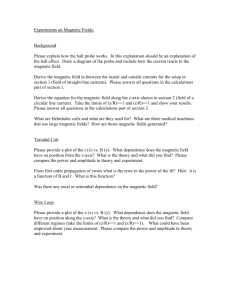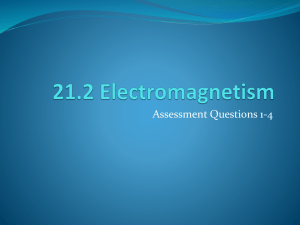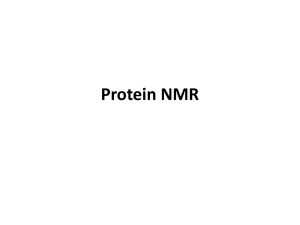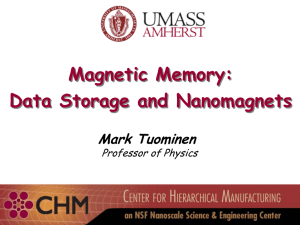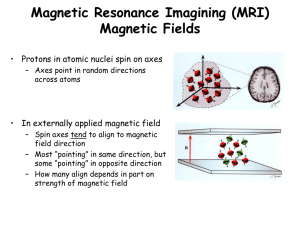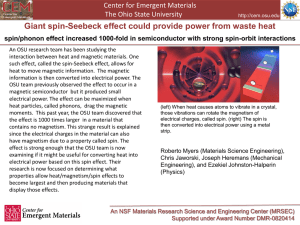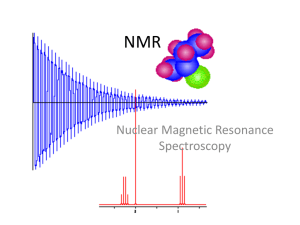Earth Field NMR Experiment - Department of Physics
advertisement
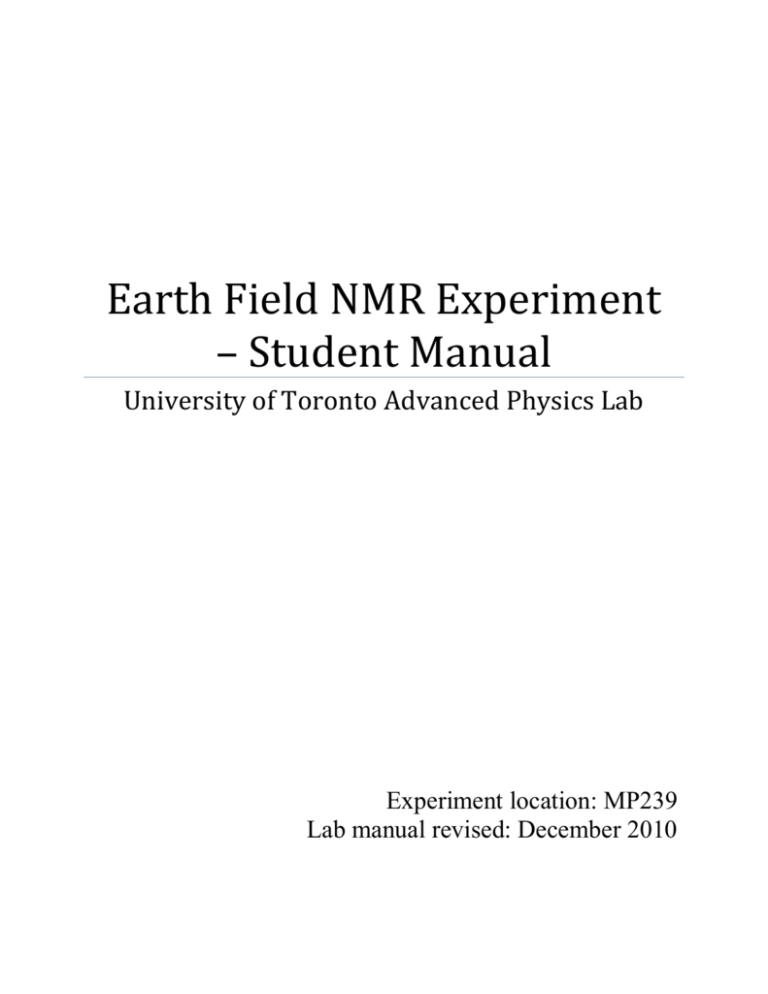
Earth Field NMR Experiment – Student Manual University of Toronto Advanced Physics Lab Experiment location: MP239 Lab manual revised: December 2010 Table of Contents INTRODUCTION TO NMR12 ............................................................................................................. 3 REFERENCES ..................................................................................................................................... 6 Part 1: Introduction to NMR – Free Induction Decay .......................................................................... 8 1.1 Background theory on EFNMR instrumentation7....................................................................... 8 1.2 Pre-lab preparation .................................................................................................................... 10 1.2.1 Suggested lab preparation .............................................................................................. 10 1.2.2 Pre-lab questions ............................................................................................................ 10 1.3 Experiment protocol.................................................................................................................. 10 1.3.1 Learning objectives ........................................................................................................ 10 1.3.2 List of required materials and equipment ....................................................................... 11 1.3.3 Safety considerations...................................................................................................... 11 1.3.4 Experiment steps ............................................................................................................ 11 1.3.5 Additional post-lab questions ......................................................................................... 14 Part 2: Spin Echo ................................................................................................................................ 15 2.1 Background theory on EFNMR instrumentation7......................................................................... 15 2.2 Pre-lab preparation ........................................................................................................................ 16 2.2.1 Suggested lab preparation .............................................................................................. 16 2.2.2 Pre-lab questions ............................................................................................................ 16 2.3 Experiment protocol...................................................................................................................... 16 2.3.1 Learning objectives ........................................................................................................ 17 2.3.2 List of required materials and equipment ....................................................................... 17 2.3.3 Safety considerations...................................................................................................... 17 2.3.4 Experiment steps ............................................................................................................ 17 2.3.5 Additional post-lab questions ......................................................................................... 18 Appendix ............................................................................................................................................. 19 A. Basic navigation in Prospa ........................................................................................................ 19 B. Suggested parameters for PulseAndCollect experiments ......................................................... 22 INTRODUCTION TO NMR12 Many nuclei are known to possess a non-zero spin angular momentum, I, and, parallel to I, a nuclear dipole moment, μ. These two vector quantities are, to a good approximation, nuclear constants independent of environment. The gyromagnetic ratio γ which relates these two quantities is defined by μ=γI (1) The energy of interaction of these magnetic dipole moments with external and local internal magnetic fields is quantized resulting in discrete energy levels. The energy differences correspond to radio frequency (r.f.) quanta, and an appropriate r.f. field will induce magnetic dipole transitions between them. They study of these levels and of the transitions between them is called Nuclear Magnetic Resonance (NMR). The frequency, ν, and the frequency spread Δν of the required r.f. radiation may be measured and controlled with precision. Typically, a 1 milliwatt, 30 MHz generator produces the order of 1022 photons per second in the Δν range. In such a radiation field the quantum theory predicts that spontaneous emission processes are completely negligible in comparison to stimulated emission and absorption processes. Since stimulated emission is identical and indistinguishable from the radiation present in the radiation field itself, only the net effect, (absorption - stimulated emission) is observable. Before applying the r.f. field, the spin system will, in general, be parallel the external magnetic field and is in thermal equilibrium with its surroundings (called the LATTICE) at a temperature T. The populations of the nuclear energy levels are then proportional to the Boltzmann factor e−En / kT . Typically, the population difference between the two proton spin levels in water in a field of 104 gauss is about 1 part in 106. Since the transition probabilities for stimulated emission and absorption are equal, it is these minute inequalities in population that make absorption slightly larger than stimulated emission and lead to a net absorption of energy by the spin system from the r.f. field. The Resonance Condition We shall assume that there is a constant external magnetic field Bo in the z direction. The nuclei that will be investigated in this experiment are the hydrogen nuclei or protons in water. The angular momentum I of the proton is 1/2 so the quantum mechanically allowed projections of this vector along the z axis are Iz = ±1/2ħ (2) The energy of interaction of the magnetic moments with the magnetic field is given by 3 E = −μ • Bo (3) E = −γ I • Bo (4) E = −γIzBo = ±1/2γ ħ Bo (5) which from equation (1) gives Using equation (2) this gives The difference in energies of the two levels is then ΔE = γħBo (6) Resonance occurs when the energy of the r.f. photons, hνo is equal to the energy separation of the levels given in equation (6). hνo = γħBo (8) ωo = γBo (7) or This frequency can induce transitions between the energy levels and is referred to as the Larmor frequency. Although these transitions are quantized, an ensemble average taken over a large number of spins behaves like a classical system. Thus classical analysis of a spinning rigid magnetized body in a magnetic field can provide significant insight.11 In this classical picture, a sinusoidal varying magnetic field, B1, corresponding to the Larmor frequency changes the magnetization direction of the nuclei into a transverse plane with respect to the static magnetic field, Bo. The spins then precess about Bo at ωo. Experimentally, B1 is obtained by locating the sample in a coil whose axis is perpendicular to the direction of Bo. In a frame of reference rotating at the Larmor frequency, the only field seen is the field B1 which is constant in the rotating frame. In this experiment relaxation mechanisms are studied by measuring the recovery of the magnetization from B1 to Bo after it has been disturbed by a r.f. pulse at the Larmor frequency. The Meaning of π/2 and π pulses In equilibrium the magnetic moments are aligned with Bo which is taken to be the z direction. The resulting magnetization is called longitudinal magnetization. When a r.f. pulse is applied at the resonant frequency, the only magnetic field seen by the nuclear magnetic moments is the corresponding magnetic field B1 and they will precess about B1. By controlling the amplitude and/or duration of an r.f. pulse, it is possible to rotate the magnetization into the x-y plane. This is called a π/2 pulse (or 90o pulse) and the resulting magnetization is called transverse 4 magnetization. Similarly a pulse of the same amplitude but twice as long will simply reverse the longitudinal magnetization. This is called a π pulse (or 180o pulse). A π/2 or π pulse, thus, disturbs the thermal equilibrium of the system; therefore, the transverse magnetization must return to zero and the longitudinal magnetization must return to its equilibrium value. The Meaning of the Time Constants T1 and T2 The time constant for the longitudinal magnetization to recover its equilibrium value in the applied field is called the spin-lattice or the longitudinal relaxation time, T1. The time constant which describes the decay of the magnetization in the x-y plane independent of magnetic field inhomogeneity effects is called the spin-spin or the transverse relaxation time, T2. After a π/2 pulse, magnetic moments precess in the x-y plane about the z axis. The axis of the sample coil is perpendicular to the z axis so the precessing transverse magnetization will induce an emf at the Larmor frequency in the sample coil. The signal is a free precession signal and decays away with time. This is called a free induction decay (FID). During this decay, the longitudinal magnetization recovers its equilibrium value as the nuclei exchange energy with the surroundings or lattice. The rate at which magnetization decays (or builds up) in a static field depends on the mechanisms available for the spins to transfer energy to something else, namely the other repositories for thermal energy such as the translations, rotations, and vibrations, collectively called the lattice. The recovery of longitudinal magnetization and T1 is described as follows Mz (t) = Mo(1 – e-t/T1) (9) where Mo is the equilibrium polarization. It is to be noted that in our discussions of spin-lattice relaxation, we assume that the spin system has a very small heat capacity so that the spin energy cannot disturb the lattice temperature. Immediately after the application of a π/2 pulse, all the magnetic moments point in the same direction in the x-y plane. During the decay to equilibrium magnetization, the transverse magnetization decays to zero. The time constant capturing this decay is T2. There may be contributions to T2 from several processes. Since each nucleus possesses a small magnetic dipole moment, there will be a magnetic dipole- dipole interaction between each pair of nuclei. Each nuclear magnet finds itself not only in the applied steady field Bo, but also in a small local magnetic field Blocal produced by the neighboring nuclear magnets. The magnetic field of a magnetic dipole falls off rapidly with distance so that only the nearest neighbors contribute to the local magnetic fields. Since the nuclei are in random motion, the local magnetic 5 fields will vary from nucleus to nucleus. Consider nuclei with their spins in the x-y plane interacting with nuclei whose spins are aligned along the z axis, the direction of Bo. The total magnetic field Bo + Blocal experienced by nuclei with their spins in the x-y plane will vary from nucleus to nucleus. Hence the precessional frequency of these nuclei will also vary. This will result in a spreading out of the spins in the x-y plane similar to the effect of inhomogeneities in the static field Bo. This dipole- dipole interaction is called spin-spin relaxation. Consider also the dipole-dipole interaction which is the reverse of the above process and which results in spin exchange. Magnetic moments in the x-y plane are precessing about the z axis at the Larmor frequency. In the rotating frame of reference a nucleus with its spin along the z axis will see a magnetic field due to a magnetic moment in the x-y plane. Since this field does not change its direction, the magnetic moment which was originally aligned along the z axis will precess about it and may end up with its magnetic moment in the x-y plane. The energy for this transition comes of course from the nucleus whose magnetic moment was initially in the x-y plane. There is a mutual exchange of energy in this spin-exchange process. Although there is no change in the energy of the system, the phases of the spins in the x-y plane is disturbed and hence T2 is shortened. The decay of transverse magnetization and T2 is described as follows Mxy =Mxyo e−t/T2 (10) If there are inhomogeneities in the static magnetic field over the dimensions of the sample then different magnetic moments will precess at different rates. In other words, some components of the magnetization start getting ahead of the average and some start getting behind. This results in a shortening of the transverse relaxation time. The time constant which describes the decay of the magnetization in the x-y plane when magnetic inhomogeneities are included is designated T2*. The exponential shape of the free induction tail depends on T2* which is always smaller than T2. T2* is related to T2 by (T2*)-1 = (T2)-1 + γΔBo (11) In the limit of very homogeneous fields, T2* approaches T2. One can get around the effects of field inhomogeneities and measure T2 directly by using the technique of spin echoes which is explained in the SpinEcho experiment. REFERENCES Key references are denoted with an asterisk 1. Jason Harlow, Nuclear Magnetic Resonance, Department of Physics, University of Toronto, October 2006 2. Pulsed Nuclear Magnetic Resonance: Spin Echoes, MIT Department of Physics, October 9, 2010 3. * A. Abragam, Principles of Nuclear Magnetism, Clarendon Press. (QC 762 A23). 6 4. P. T. Callaghan et al., Earth’s Field NMR in Antarctica: A Pulsed Gradient Spin Echo NMR Study of Restricted Diffusion in Sea Ice, Journal of Magnetic Resonance, Volume 133, Issue 1, July 1998, Pages 148-154. 5. T.C. Farrar, Pulse and Fourier Transform NMR, Academic Press (QC 454 F34 1971). 6. E. Fukushima and S.B.W. Roeder, Experimental Pulse NMR, Addison-Wesley. (QC 762 F85). 8. * E.L. Hahn, Free Nuclear Induction, Physics Today, Vol. II, No. 11, 1953. 7. * Magritek Limited, Terranova-MRI EFNMR Student Manual, 2009. 9. M. E. Halse et al., A practical and flexible implementation of 3D MRI in the Earth’s magnetic field, Journal of Magnetic Resonance Volume 182, Issue 1, September 2006, Pages 75-83. 10. R.S. Macomber, A Complete Introduction to Modern NMR Spectroscopy, John Wiley & Sons (QD 96 N8M3 1998). 11. * R.T. Schumacher, Introduction to Magnetic Resonance, W.A. Benjamin. (QC 762 S34). 12. K.R. Symon, Mechanics, 2nd Edition, Addison-Wesley. (QC 125 S98 1961). 7 Part 1: Introduction to NMR – Free Induction Decay 1.1 Background theory on EFNMR instrumentation7 This experiment is performed using the Terranova-MRI EFNMR apparatus. Conventional NMR instrumentations generate a large static magnetic field Bo (> 0.3T) to achieve bulk magnetization in the sample. The Terranova-MRI EFNMR apparatus, however, is relying on the highly homogeneous Earth’s magnetic field BE (54μT). When properly aligned, the outermost prepolarization coil of the probe magnifies BE by 350 times and increases bulk nuclear magnetization, Mz, of the sample along the direction of the Earth’s field (assumed to be along the longitudinal z direction). This is the equilibrium magnetization of the sample. When the innermost B1 coil generates a 90o RF pulse at the Larmor frequency (ω = γBE for a particular duration, a magnetic field B1 in the transverse plane is generated. This field rotates the sample’s magnetization into the x-y plane, resulting in a transverse magnetization, Mxy. As B1 is removed, Mxy starts to precess about the z direction at the Larmor frequency with a decay. This precession is detected by the B1-coil to generate the Free Induction Decay (FID) spectrum (see Figure 1). The software takes the Fourier Transform of this signal to generate a frequency spectrum with a peak at the Larmor frequency. Figure 1: 90o pulse sequence diagram. 7 System capacitance In this instrumentation, the innermost B1-coil behaves as both the excitation and detection coil. When connected to the spectrometer, the B1-coil forms a parallel LCR circuit. The B1 coil is an 8 inductor with an inductance, L, and an internal resistance, R. it is connected in parallel to a fixed capacitance, C, within the spectrometer. The circuit will resonate at a frequency w0 given by: ωo = (LC)1/2 (12) By changing the B1 capacitance value in the software, the B1-coil can be tuned to generate a RF pulse at the Larmor frequency. Macros used for instrument tuning and signal optimization7 Excitation coil analysis – AnalyzeCoil macro The AnalyzeCoil experiment characterizes the transmitting/receiving B1-coil for instrument tuning purposes. By applying impulses to the B1-coil over a range of capacitance values, the resonance response of the coil is determined. An analysis of this response calculates the inductance and the parasitic capacitance of the coil. Note that this macro needs to be run without any sample in the probe. Record the B1 inductance and B1 capacitance as displayed in the CLI window. These values will be used in other experiments to determine the self-resonance of the coil. Shimming – AutoShim macro Earth’s magnetic field is naturally highly homogeneous. However, the field is so weak (~50μT) that its homogeneity is easily disrupted by the proximity of ferrous objects or other sources of magnetic field. Inhomogeneity can cause phase coherence loss and lead to rapid signal decay. Local magnetic field inhomogeneities introduce a range of Larmor frequencies across the sample. Each spin then will precess at a Larmor frequency associated with its position. Magnetic field homogeneity can be greatly improved using shimming. Shimming is the process of iteratively applying weak position dependent magnetic fields across the sample until the applied fields cancel the underlying inhomogeneity of the static field. This is achieved by passing small currents through a collection of coils designed to generate magnetic fields of specific geometries such as a magnetic field that changes linearly along one axis (field gradient). The apparatus employs three shim coils, which correspond to field gradients along the x, y and z axes. Shimming parameters are very sensitive to changes in the environment; therefore when the probe has been moved or large metal objects in the vicinity of the probe have been moved, the shimming process must be repeated. The software contains the macro Autoshim, which performs shimming in an automated manner by running a series of the pulse and collects sequence. B1 pulse duration The B1Duration macro runs a series of pulse and collect sequences with varying excitation pulse durations. A pulse duration corresponding to a tip angle of 90o yields the maximum signal. In the plot of signal amplitude versus B1 pulse duration, the first maximum yields the optimal 90o pulse duration. 9 1.2 Pre-lab preparation 1.2.1 Suggested lab preparation 1. Watch the following videos: Introductory NMR & MRI: Video 04: Acquiring a Free Induction Decay (FID) http://www.youtube.com/user/magritek#p/u/7/MPXbDDRumwM Introductory NMR & MRI: Video 05: Field Homogeneity http://www.youtube.com/user/magritek#p/u/6/o8PzreUSbVE 1.2.2 Pre-lab questions 1. Calculate the Larmor frequency of the water sample, given that the gyromagnetic ratio for a hydrogen nucleus is 2.675x108T-1s-1. 2. How does inhomogeneity in the Earth’s magnetic field affect the amplitude and the frequency spectrum of a free induction decay signal? 3. What are possible sources of magnetic field inhomogeneities in a lab environment? 4. Figure 2 displays the root mean squared (rms) value of noise detected by the EFNMR probe. Based on their frequencies, what is the likely origin of the two distinct peaks observed? Figure 2: MonitorNoise experiment output 1.3 Experiment protocol 1.3.1 Learning objectives In this section of the experiment, students will: Apply nuclear magnetic resonance (NMR) in Earth’s magnetic field (EFNMR) to obtain a signature Free Induction Decay (FID) signal of hydrogen atoms in a water sample Optimize the quality of an NMR signal through shimming and parameter optimization 10 Investigate the effects of field inhomogeneity and other implementation challenges The experiment introduces the protocol for optimizing the NMR signal which will be used prior to all further experiments in order to ensure the highest quality results possible. 1.3.2 List of required materials and equipment Magritek EFNMR probe, spectrometer and computer with Prospa software 570ml bottle of water Magnetometer Probe platform (in this case, a strong cardboard box) Wooden probe stand Figure 3: Key components of the EFNMR instrumentation. 7 1.3.3 Safety considerations As part of setup, the probe stand and the probe (a combined weight of ~4 kg) have to be lifted to a height of ~1.3m for placement on the probe platform. Should you require assistance in lifting the probe onto the platform, ask the TA for assistance. To minimize trip hazards, ensure that the area around the EFNMR station is clear of any other objects. When the probe is in operation, keep magnetically sensitive objects (e.g. watches, magnetic swipe cards) at least 3m away from the probe to avoid potential damage. When running the experiments, do not let the coil temperature run beyond 40oC. Cease experimentation when the probe is warmer than body temperature and resume when the probe has cooled down sufficiently. An IR thermometer may be available for monitoring the probe’s temperature. 1.3.4 Experiment steps Aligning the probe 1. Place the wooden probe stand on the provided platform. Place the probe on the stand (Figure 4). 11 Figure 4. Final setup of the probe and stand on the NMR platform. 2. Rotate the probe until the arrow on the probe aligns with a magnetometer pointed in the zdirection (Fig. 5a). Orient the probe stand at 90o to the Earth’s magnetic field (Fig. 5b). 5a. 5b. Figure 5. Alignment of the probe. Figure 2a shows the correct alignment of the probe in the zdirection. Figure 2b demonstrates the correct alignment of the probe wrt. the Earth’s field. 3. Open the Prospa software and turn on the spectrometer. The spectrometer’s red power light and green USB light will both illuminate. 4. Open EFNMR >MonitorNoise experiment in Prospa (Figure 6). Enter your calculated Larmor frequency in the “B1 frequency” field. Figure 6: MonitorNoise parameter screen. 5. Minimize the noise of the probe by fine-tuning the probe’s alignment. Aim to achieve an rms noise signal of 7.5µV or less. 12 Note 1: To view plots of the experiment output in real time, select 1D Window under the Window menu. Additionally, a text read-out of the experiment results can be obtained by selecting Command Line Interface under the Window menu. Note 2: The maximum allowable noise signal is 8.5µV. Beyond this value, it will be difficult to obtain a good quality signal. Tuning the probe capacitance 6. To tune the capacitance of the system, run EFNMR > AnalyzeCoil experiment to obtain the self-capacitance (Ccoil) and self-inductance of the coil (Lcoil) from the CLI window. The AnalyzeCoil experiment characterizes the B1 transmit/ receive coil by applying an impulse to the B1 coil and detecting the response. This procedure is repeated over a range of capacitance values in order to determine the parameters of the B1 coil. a. Calculate the total required capacitance (Ctotal) using the resonance circuit equation: ωo = (Lcoil Ctotal)1/2 (13) , where ωo is the desired resonance frequency. b. Calculate the new capacitance value: Csoftware = Ctotal - Ccoil. Record this value for use in future experiments. Note: There should be no water sample in the probe during the AnalyzeCoil experiment. Obtaining a free induction decay signal 7. Open EFNMR >PulseAndCollect experiment and enter your calculated Larmor frequency in the “B1 frequency” field and the calculated capacitance (Figure 7). Figure 7: PulseAndCollect parameter screen. 8. Place the water sample in the probe and run the PulseAndCollect experiment. The presence of a distinct sample peak confirms that the machine has been set up correctly. Confirm the presence of the peak by removing the water sample from the probe and rerunning the experiment. 9. If the signal peak frequency falls within 10% of your calculated value, adjust the B1 frequency to match the observed frequency. Also, calculate and enter the new required 13 capacitance value. Rerun the PulseAndCollect experiment. Use these values for all the ensuing experiments during this lab period. Optimizing the signal 10. Open EFNMR > Autoshim experiment and set the B1 frequency to the frequency of the signal obtained previously. It is important to limit the display range such that the noise peaks are not included in the scanned frequency. Choose a range between 50-100Hz. The Autoshim experiment runs for 10-20 minutes. Upon completion, save the new shim values. The updated shim values will be automatically applied to all future experiments. 11. Repeat the PulseAndCollect experiment and compare the signal with the pre-shim results 12. Obtain the correct pulse duration for the 90o pulse by running EFNMR > B1Duration experiment. The output is a plot of NMR signal amplitude versus pulse length. Determine the optimal pulse duration for the 90o excitation pulse from this plot. 13. Re-run the PulseAndCollect experiment with the new pulse duration and compare the results with previous signals. 14. Investigate the effect of ferromagnetic objects on the probe. How does this affect the NMR signal? 1.3.5 Additional post-lab questions 1. Why is a homogeneous magnetic field important for NMR experiments? How is the FID signal affected when the magnetic field is inhomogeneous? 2. Comment on the stability of the peak during the experiments. What are the possible reasons for this observation? 3. Based on the resulting NMR signals, what was the effect of the various signal optimization steps? Comment on changes in amplitude signal, resolution and signal to noise ratio. 14 Part 2: Spin Echo 2.1 Background theory on EFNMR instrumentation7 An NMR signal originates from the atoms relaxing to equilibrium magnetization as they precess along the z direction. This precession induces an emf in the detection coil at the Larmor frequency and is characterized by an exponential decay. The decay is attributed to loss of coherence in the signals due to two mechanisms - spin coupling between neighboring atoms and inhomogeneities in constant magnetic field Bo. In this experiment the effect of inhomogeneous magnetic field is examined. Recall from Pulse and Collect experiment, the precession frequency of the atoms is at the Larmor frequency, ω=γBo, which is linearly dependent on the local magnetic field Bo. Non-uniformity in the constant magnetic field then results in different precessional frequencies that vary depending on the atoms location and local magnetic field. Thus spins become de-phased and the signal decays at a faster rate captured in the time constant, T2*. Spin echo is a technique aimed at compensating for signal de-phasing due to inhomogeneity in magnetic field. After a 90o excitation pulse, the transverse magnetization precesses same as in the Pulse and Collect experiment. However, precession of the atoms fans out due to nonuniformities in magnetic field. A 180o pulse applied at time τE (echo time) flips magnetization of all atoms along y-direction, effectively reversing the direction of precession. This will cause the faster precessing atoms to be behind those precessing more slowly. After another τE the nuclei will be re-phased as the faster precessing atoms catch up in phase and produce a coherent NMR signal. This pulse sequence is illustrated in Figure 1. Figure 1: Pulse sequence diagram for a typical spin echo experiment. 7 15 2.2 Pre-lab preparation 2.2.1 Suggested lab preparation Watch Video 06: Spin echoes, CPMG and T2 relaxation (10:10 min.) http://www.youtube.com/watch?v=B2HMAJQJ7ok 2.2.2 Pre-lab questions 1. Do you expect any difference in signal obtained with spin echo versus that obtained with PulseAndCollect? If yes, what are the differences? If no, why not? 2. Which time constant can be measured using the spin echo? Explain how the constant can be measured. 3. In the last experiment, the B1Duration experiment ran a series of single pulse experiments at varying pulse lengths. The output is a plot of NMR signal amplitude versus pulse length which the experimenter was used to determine the optimal pulse duration for the 90o pulse duration (Figure 2). The same plot can be used to determine the 180o pulse. How would you determine the pulse duration for the 180o pulse from the plot? Figure 2: Plot of NMR signal amplitude versus pulse length (B1Duration experiment output) 2.3 Experiment protocol 16 2.3.1 Learning objectives In this experiment, students will observe and explain the: Difference between results obtained from free induction decay (Pulse and Collect) and spin echo experiments Effect on critical parameters such as 90o pulse and 180o pulse durations and echo time on spin echoes Effect of inhomogeneity on spin echo and free induction signals 2.3.2 List of required materials and equipment As described in Part 1. 2.3.3 Safety considerations As described in Part 1. 2.3.4 Experiment steps 1. If starting this experiment in a new lab session, obtain an FID of the water sample and optimize the signal as described in the free induction decay experiment. 2. Obtain the correct pulse durations for the 90o and 180o pulses by running the B1Duration experiment. 3. Open EFNMR > SpinEcho experiment dialogue and enter the pulse durations determined from the B1Duration experiment. Use an echo time of 100ms. Leave the other parameters unchanged. 4. Run the SpinEcho experiment and record the result for comparison with spin echo experiment you will run after shimming. Run the PulseAndCollect experiment as well and record the results. What are the differences between the signals obtained from these two pulse sequences? 5. Run EFNMR > AutoshimSE experiment. This shimming program optimizes the shim values for spin echo experiments specifically. The experiment will automatically update the shim values upon completion (7-10 minutes). Record the new shim values. 6. Run the SpinEcho experiment. Record the result. How does the new signal compare with the signal obtained before shimming? 7. Run the SpinEcho experiment with echo times ranging from 50ms to 2000ms, recording the results of the integral under the peaks for each echo time (obtained from the experiment result summary in the command line interface window) and screenshots of the signals. 17 8. Investigate the effect of field inhomogneity on spin echo signals. Open the shim dialogue on the SpinEcho dialogue and change the shim values (e.g. by 10%) to make the field inhomogeneous – do not save these values. Record the new shim values. Run the SpinEcho experiment with echo times ranging from 50ms to 2000ms, recording the results of the integral under the peaks for each echo time and screenshots of the signals. How do the results compare to the results of the well-shimmed case? 9. Open the shim dialogue on the PulseAndCollect experiment dialogue and enter the same shim values used to create inhomogeneity during the previous SpinEcho experiment. Do not save these values. Run the PulseAndCollect experiment and record the results for comparison with the well-shimmed case. 2.3.5 Additional post-lab questions 1. Plot the integral of the frequency peak versus echo times. Explain the relationship between these two values. 18 Appendix A. Basic navigation in Prospa Viewing the 1D Plot Window Viewing the 1D Plot Window 1. Open the Prospa program from the Desktop. 2. If the experiment window is not visible, open the Window menu and select “1D Window”. A blank 1D plot will appear. 19 Viewing the 1D Plot Window Running experiments and viewing experiment results Running experiments and viewing experiment results 1. Open the EFNMR menu and select the experiment name. 2. After selecting an experiment, an experiment parameter screen will appear. Enter the parameters as instructed in the lab manual. 20 Running experiments and viewing experiment results 3. Select “Run” to start the experiment. The experiment output will be displayed in the 1D Window as the experiment progresses. The experiment will automatically stop upon completion. Note: To stop an experiment before it is completed, select “Stop” in the experiment parameter screen. There will be a slight delay before the software halts the experiment. After this delay, the user can start a new experiment run or new experiment. 4. To obtain the coordinates of a point on the plot, select the “Display data value” button . A cross hair cursor will appear in the 1D window. Click and drag the cursor until it snaps onto the point of interest. The coordinates will appear on the bottom left of the screen. 5. To view more detailed information on the experiment results, open the Window menu and select “Command Line Interface” or CLI. The command line interface screen will appear. The screenshot below is an example of the CLI after the PulseAndCollect experiment was executed. 21 Running experiments and viewing experiment results B. Suggested parameters for PulseAndCollect experiments Parameters B1 frequency Pulse duration Acquisition time Number of data points Acquisition delay Average Display range Transmit B1 gain Capacitance Receive gain Parameter description Set to Larmor frequency of the sample. The Larmor frequency is dependent on the gyromagnetic ratio of the observed nucleus and the strength of the Earth’s magnetic field. Controls the tip angle of the excitation. Determine the number of, and time between adjacently sampled points. Suggested initial values 1800Hz to 2500Hz Time delay between the excitation of the sample and the detection of the signal A single scan can be used for the initial experiment. However, if difficulties arise in finding a strong signal it may be beneficial to employ many averages and thus improve the signal-to-noise ratio of the acquired FID and spectrum. Controls the range of frequencies which will be displayed in the spectral window. Determines the amplitude of the B1 excitation pulse (volts). It dictates the tip angle of the excitation. If the transmit gain setting is decreased, the required length of the 90o and 180o pulse will increase. Determines the resonant frequency of the B1 coil Controls the degree of amplification of the received signal. If clipping occurs on the FID signal, reduce the receive gain. 25ms 1.5ms 1s 16384 points check 2.5 10nF ( 4.4 -17.15nF) 2 (0-10) 22
